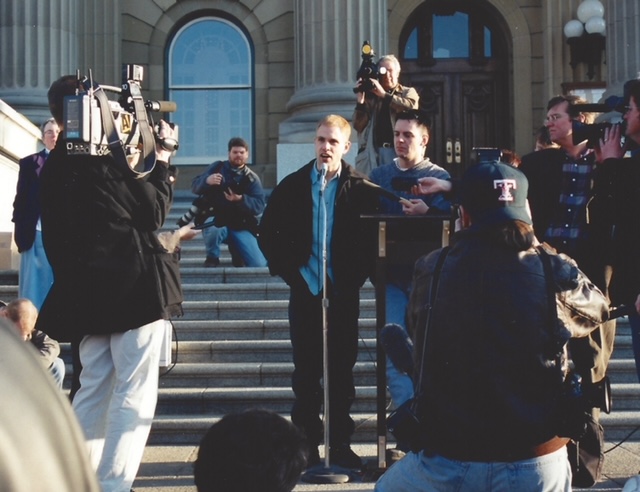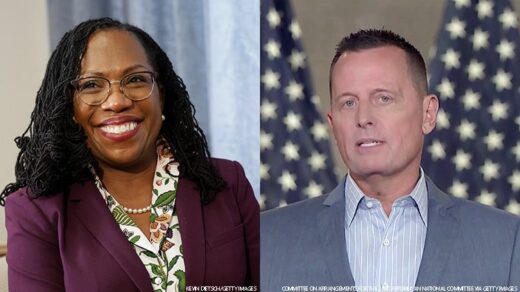The Facts in the Case of D. Vriend
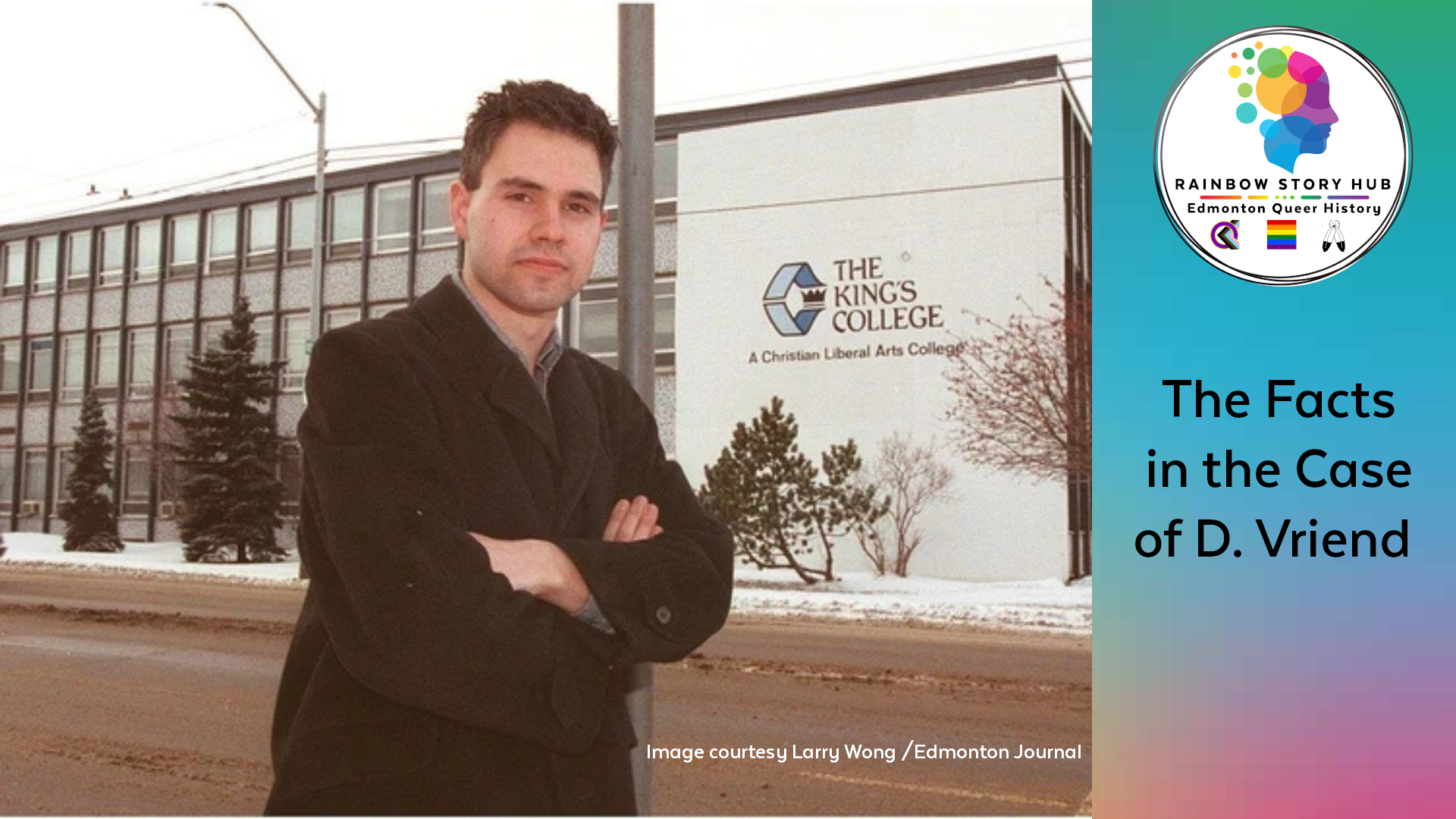
The history of civil rights in Canada is largely one of misdirection, a kind of social-justice magic trick intended to make us believe this nation has always been more enlightened than the reality. I mean this intersectionally, of course, but in my time researching for Rainbow Story Hub, my lens has been queer specific — we, as a marginalized community, were fighting for even the most basic of rights yesterday.
The Vriend v. Alberta civil rights case is one such recent landmark. Significant in the history of Canadian LGBTQ+ rights, particularly in the realm of employment discrimination. Vriend’s story is not just about one man’s struggle but about the legal recognition of sexual orientation as a protected category under Canadian law, forever changing the landscape of human rights in not only the province but the broader country.
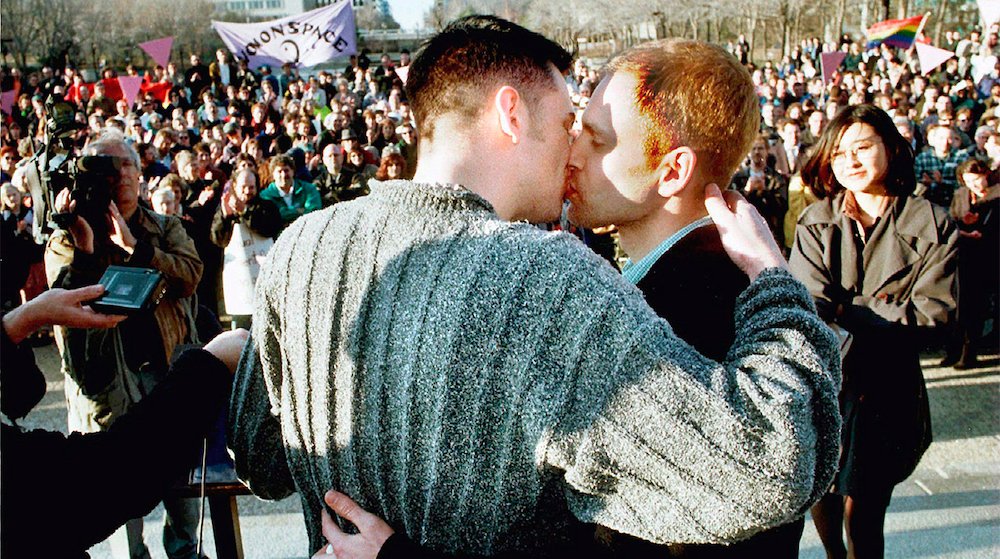
Photo by Ian Jackson /Edmonton Journal
In 1991, Delwin Vriend was employed as a lab coordinator at The King’s University College, a private Christian institution in Edmonton, Alberta. Vriend was well-regarded in his position, and by all accounts, his sexual orientation had not affected his performance or relationship with students and colleagues. However, when his superiors learned that Vriend was openly gay, he was promptly and unceremoniously dismissed — not for performance issues, not for misconduct. No, nothing as clean as that. He was fired for daring to exist as a gay man at a Christian institution. They might as well have branded him with a scarlet letter; King’s College had just set a dangerous precedent.
Seeking justice, Vriend took his case to the Alberta Human Rights Commission, thinking — maybe a little too optimistically — that they might back him. He was wrong again. At the time, Alberta’s Individual Rights Protection Act didn’t even bother to list sexual orientation as a protected category. We’d now consider that a fairly glaring omission, like forgetting to put brakes on a car, but it’s important to note that this was — for the time — uncharted territory. You could not discriminate based on race, gender, religion, sex, but the letter of the law made no mention of sexual orientation. Vriend’s case, therefore, was rejected outright.
There is a certain Southern Alberta saying where I grew up — “if you kick a dog long enough, it will bite”. Evidently, two kicks were enough for Vriend.
Unwilling to accept the current hegemony’s failure to protect him (and by extension, other queer people), Vriend launched a legal challenge, arguing that the omission of sexual orientation from human rights laws was a blatant violation of Canada’s Charter of Rights and Freedoms. His legal team asserted that the omission itself amounted to discrimination, as it left LGBTQ+ individuals vulnerable to unfair treatment, particularly in employment, housing, and other fundamental areas of life.
The case moved through the legal system as a kind of windstorm, first being heard by the Alberta Court of Queen’s Bench. In 1994, the court ruled in Vriend’s favor, stating that the exclusion of sexual orientation from Alberta’s human rights laws was indeed unconstitutional. The court “read in” sexual orientation to the IRPA, effectively making LGBTQ+ a retroactive protected category.
However, this victory was short-lived. Alberta’s government — a pack of conservatives led by Premier Ralph Klein — wasn’t about to let a queer nobody change their laws. They appealed, and in 1996, the Alberta Court of Appeal reversed the lower court’s decision; the official statement said sexual orientation wasn’t the court’s business, citing it as a “legislative choice” and implying that the exclusion of protections on sexual orientation was a feature, not an oversight.
Vriend and his legal team refused to give up and appealed the case to the Supreme Court of Canada. By this point, it had transcended being one man’s discrimination case and was now akin to a kind of ideological trench war, a proxy fight for the broader issue of queer existence in a conservative province where the line between Church and State was (and frequently still is) painfully thin.
In 1998, the Supreme Court finally rendered a verdict, and it came down like a hammer — Vriend wins, with an 8-1 ruling in favor of recognizing sexual orientation as a protected ground under the Charter; the omission was in violation of Section 15. Crucially, the Supreme Court also ruled that the province could not use the “notwithstanding clause” to override this Charter protection — to do so would not only be flat homophobia, but would be, in no uncertain terms, unconstitutional.
This ruling had sweeping implications. Vriend’s case became a legal benchmark that resonated across Canada. Suddenly, every LGBTQ+ person had a new shield in their fight against discrimination. Vriend’s personal resistance became an out-loud public victory, one that cracked open the closet doors Alberta had tried so hard to nail shut. Vriend v. Alberta established that sexual orientation was a category deserving of protection under the Canadian Constitution. Is that protection barely older than the Disney film Tarzan? Sure. But, as with any legal precedent, late is certainly better than never.
For Vriend, the case was a vindication of his personal fight for justice, but its impact rippled far beyond his own experience. It was a pivotal moment in the battle for LGBTQ+ equality, helping to cement legal protections for sexual minorities and pushing Canada closer to full legal recognition of LGBTQ+ rights. His bravery in taking on this battle paved the way for future generations to live freer, more equitable lives. The Delwin Vriend case remains a crucial chapter in the story of LGBTQ+ rights in our province, but also in Canada—a reminder that the struggle for equality is both a personal and collective journey. Every victory we as queer people win, every precedent we set, and every success we achieve, helps entrench our personhood in the annals of history — we keep fighting not just for ourselves, but all those that come after.
COMING SOON!
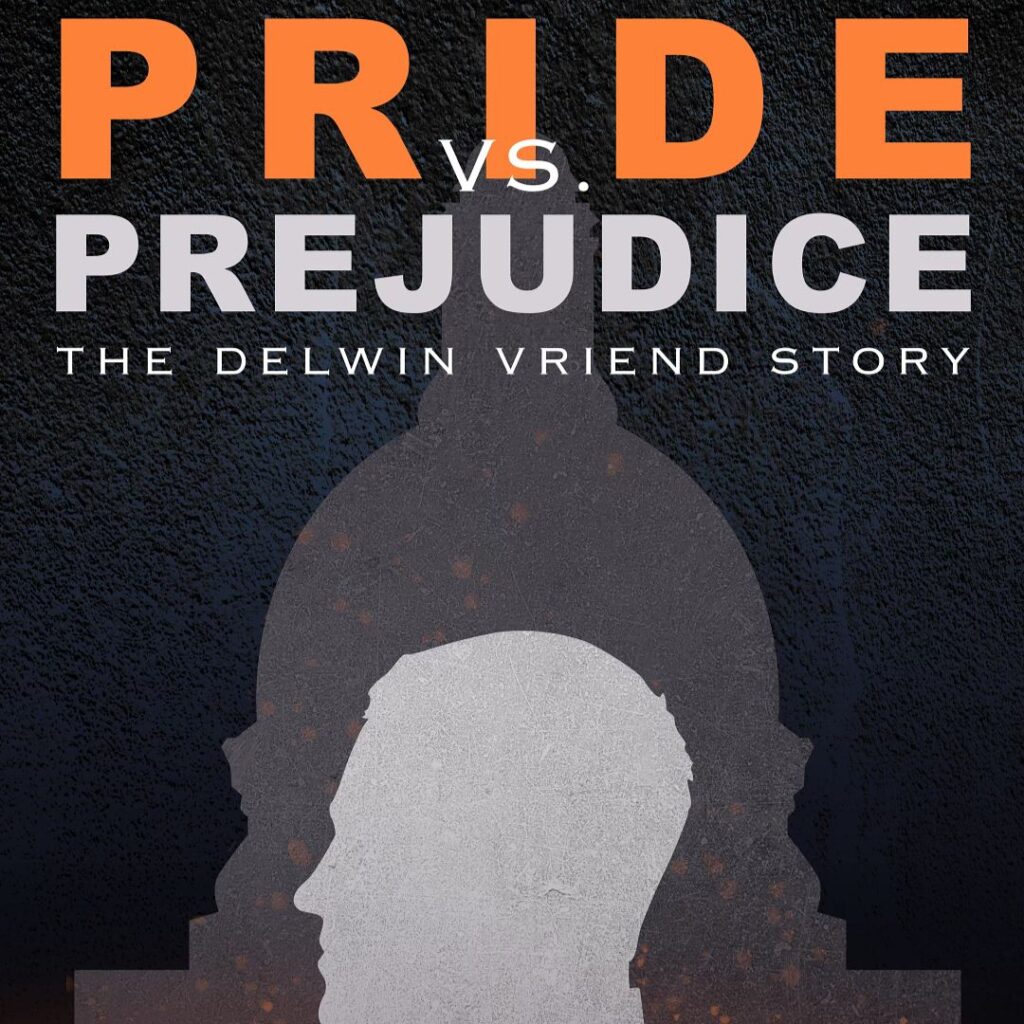
PRIDE vs. PREJUDICE: The Delwin Vriend Story
Nancy Power Theatre
General (G)
Sat Nov 2: 7pm
10708 124 Street NW
Edmonton, Alberta
P 780 453 2440
Tickets:
https://theatrenetwork.ca/events/pride-vs-prejudice-the-delwin-vriend-story/
Delwin Vriend never wanted to be a human rights activist, but in challenging his firing for being gay, he set in motion a chain of events that impacted the lives of LGBTQ+ people —not just in Alberta, not just in Canada, but around the globe.
Delwin Vriend never wanted to be a human rights activist, but in challenging his firing for being gay, he set in motion a chain of events that impacted the lives of LGBTQ+ people — not just in Alberta, not just in Canada, but around the globe.
The Film:
WRITTEN & DIRECTED BY
Darrin Hagen
https://www.pridevsprejudice.com
A PRODUCTION OF
Edmonton Community Foundation
Edmonton Queer History Project
EXECUTIVE PRODUCER
Douglas Stollery
ASSOCIATE PRODUCER
Andrew Paul
IMPACT PRODUCER
Kristopher Wells

Aldynne Belmont
Aldynne H. Belmont is an American-Canadian lesbian, writer, lover of storytelling, and sometimes-showgirl, in that order. Aldynne has happily become entangled in the wide and wonderful web of YEG’s queer scene since moving to the city in 2020, and is a graduate of Edmonton’s own University of Alberta with a Bachelor’s in English and Film.
Her published work includes essays, journalism and theatre. Most recently, her stage play Ride Lyke Hell — described as a “lesbian friends-to-lovers romantic-comedy road-trip post-western” — debuted as a stand-out at Theatre Network’s Nextfest 2024.
She is both proud and absolutely giddy to be making a “serious, grown-up girl career” of the written word. Aldynne lives with her beautiful partner, two cats, and a very loud little dog in a townhouse designed by Wallbridge and Imrie.
Spread the word! Share this story now
20Shares
Advertisements


